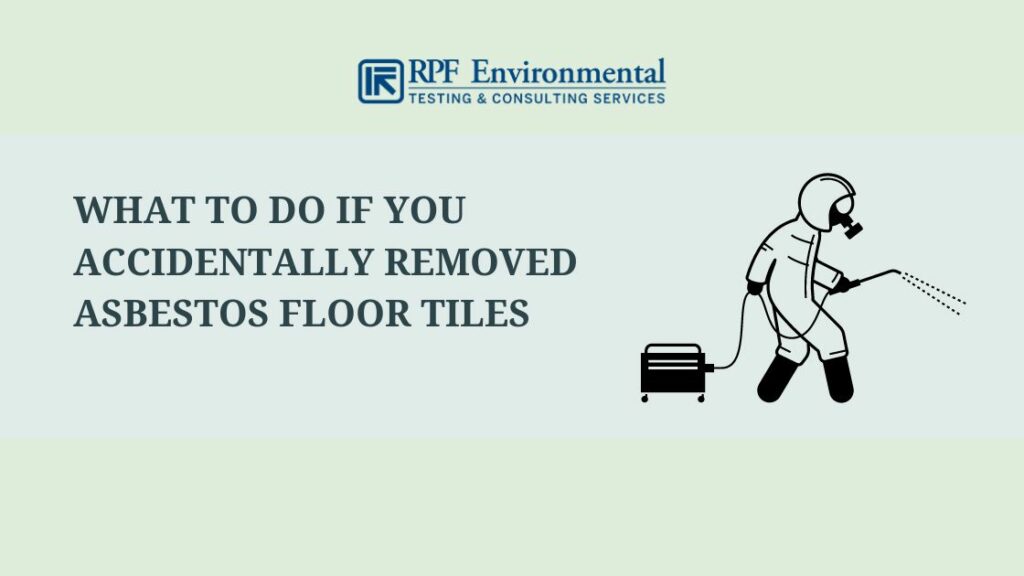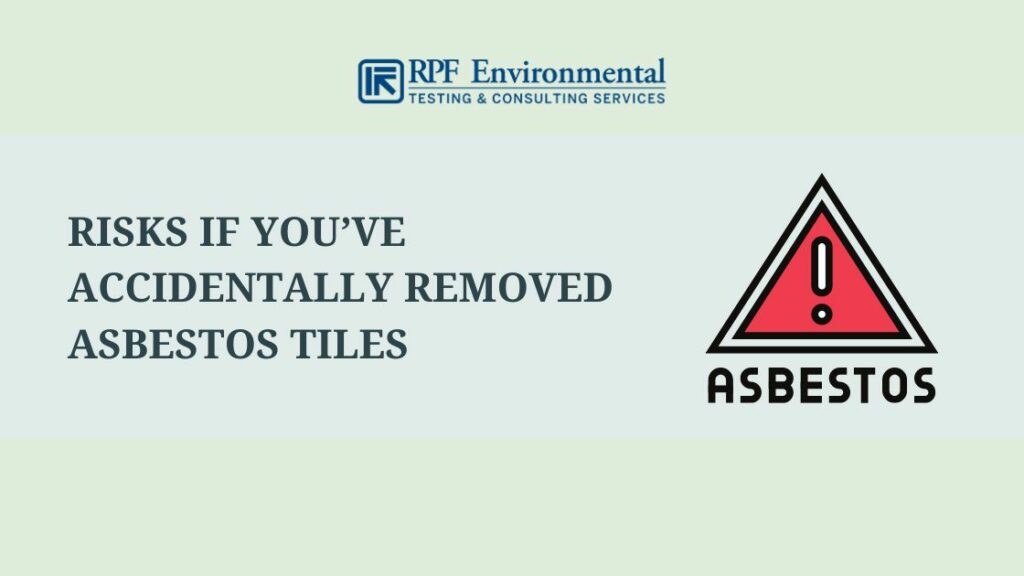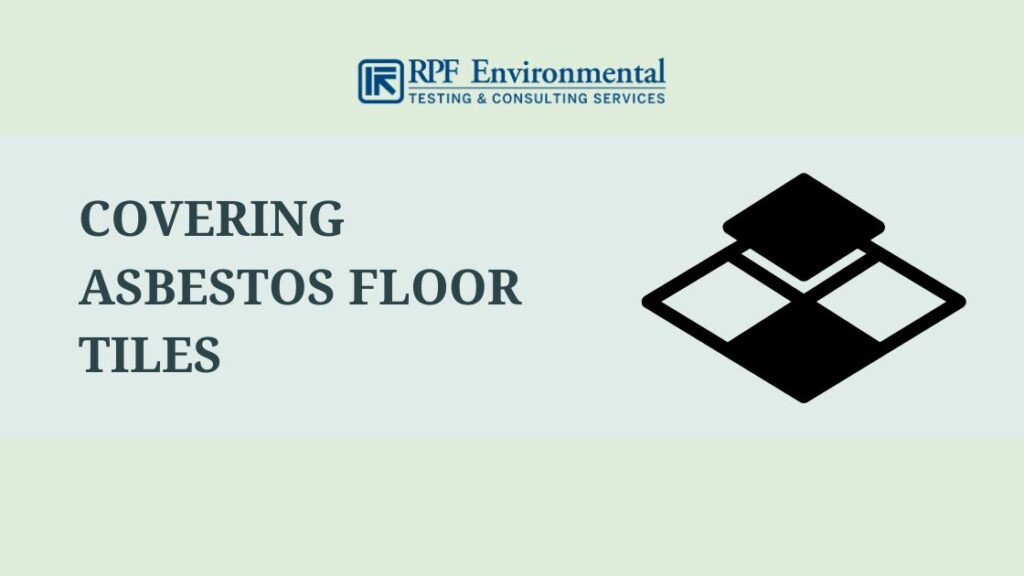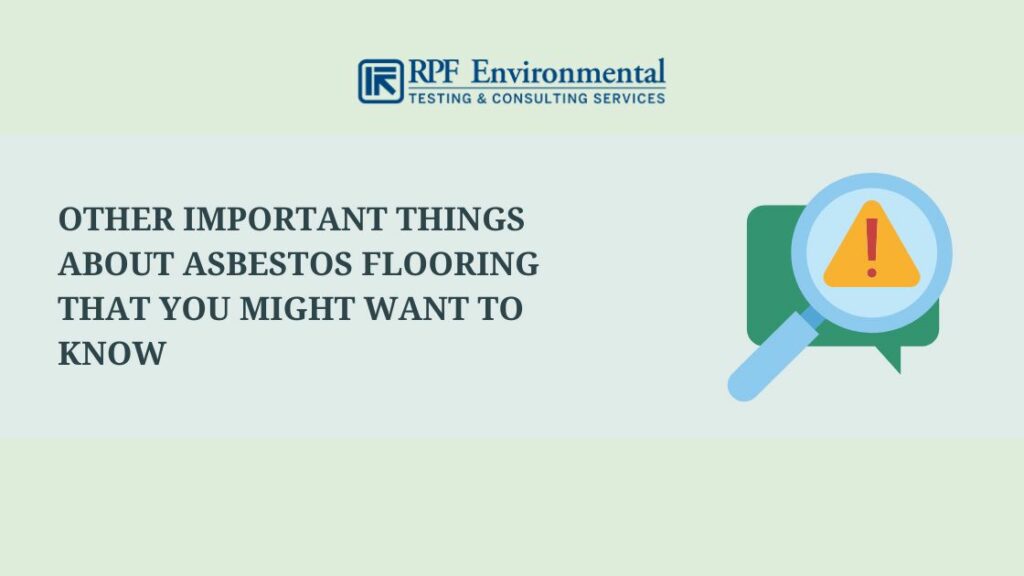What if you accidentally removed asbestos tiles during a home renovation or remodeling project and don’t know what you should do next? The first step is to not panic and stop disturbing the tiles further to avoid possible exposure in case they do contain asbestos. But, know that if your house is old and was built from the 1920s to the 1980s, there is a high chance that the tiles are made with asbestos.
Here, we will give you a step-by-step guide on what you should do if you’ve accidentally removed asbestos flooring. We’ve also included other important information, including covering asbestos tiles, that might help you.

RPF Environmental can help you test for asbestos tiles and other asbestos materials in your home at affordable prices. We serve every state in the nationwide. Reach out to us now!
What to Do if You Accidentally Removed Asbestos Floor Tiles

The initial step is to stop what you are doing to prevent toxic asbestos dust from becoming airborne. Do not sweep or vacuum the area. Close off the affected area instead to avoid contamination and prevent airborne fibers from spreading throughout your home.
Do NOT attempt to repair damaged asbestos flooring tiles yourself. Improper handling can spread the asbestos fibers further and put your family at risk of exposure.
Step 1. Have the Suspected Asbestos Flooring Tested
Have the tiles tested to confirm if they actually contain asbestos as soon as possible. This way, you’ll know if you can resume removing them yourself or hire a licensed abatement company.
How to Test for Asbestos Tiles
There are two ways you can test flooring tiles for asbestos: DIY asbestos test kits and professional testing.
Method 1. Home Asbestos Testing Kits
You can buy these kits in home improvement stores. The kits usually include sample bags, plastic gloves, usage instructions, and an order form so you can take samples yourself and mail them to a lab. You need to pay additional fees for lab testing if you choose this option.
NOTE: If you decide to test the tiles yourself (which we don’t recommend), make sure that you follow the instructions properly to avoid exposing yourself. According to EPA, “sampling can be more hazardous than leaving the material alone”.
Method 2. Hire a Certified Asbestos Testing Professional
We recommend hiring a licensed asbestos testing company instead of DIY testing. You will be paying more, but you can rest assured that you and your family are safe from the harmful effects of inhaling asbestos fibers. Asbestos testing companies use advanced equipment to accurately test for asbestos in your home.
Also Read:
Step 2. Remove the Asbestos Tiles
Damaged tiles should be removed as soon as possible once it is confirmed that they do contain asbestos to prevent further exposure.
Things to Take Note of Before Removing Asbestos Tiles Yourself
Do not try to remove asbestos tiles and other asbestos-containing materials yourself unless you are properly trained and your local laws allow you to. Many areas prohibit homeowners from doing DIY asbestos removal and will require a certified abatement company. Also, improper removal can create hazards where none existed before.
If you insist on doing the removal yourself, find out about asbestos laws in your area first before doing anything. This way, you can avoid penalties associated with unauthorized asbestos removal and disposal.
How to Remove Asbestos Tiles
Below are the basic steps for removing asbestos tiles:
1. Preparation
Wear proper protective gear and prepare the needed materials:
- Full-face respirator
- Disposable gloves
- Disposable coveralls
- Disposable shoe covers
- Plastic sheeting to isolate the area
- Pump pressure sprayer to wet the material
- HEPA vacuum for cleaning
- Adhesive remover, putty knife, heavy-duty plastic bags, and others
2. Wet the Tiles
- Wet the tiles to avoid releasing asbestos fibers into the air during the removal process. Water helps hold the fibers together to reduce the risk of exposure.
3. Remove the Tiles
- Use the putty knife to pop the tiles loose and lift them off the floor carefully. You can use a hammer to make prying up the tiles easier.
- Avoid breaking or sawing the tiles. If it is really necessary, use a wet tile saw.
4. Place the Waste in Sealed Bags
- Place the asbestos waste and other disposable protective equipment you used in heavy-duty plastic bags.
- Seal the bags tightly.
- Put clear labels (e.g. “Asbestos Waste”) on the bags.
5. Clean Up After Removing All Asbestos Tiles
- Clean the area with a HEPA vacuum thoroughly.
- Wet mop with soapy water.
- Keep the area sealed off until you can ventilate it properly.
6. Dispose of the Waste Properly
- Dispose of the waste according to your local laws and regulations. You can contact your jurisdiction for proper disposal methods.
- Do not throw the waste in regular dumpsters to avoid liabilities. Throw them in certified hazardous waste facilities in your area.
Related Question: Can You Remove Carpet Over Asbestos Tile? Can Asbestos Come Through the Carpet?
We do not recommend removing carpet that is glued to asbestos tiles. Although carpets don’t usually contain asbestos, you might inhale toxic asbestos fibers when you accidentally tear, cut, or break the tiles while removing the carpet. Hire a licensed professional to do the job.
Better Hire a Professional Asbestos Removal Company Instead of Doing It Yourself
Hiring a professional might be expensive, but DIY removal is not worth the risk and may even be more expensive in the long run. Asbestos removal or abatement companies are trained to handle asbestos materials properly, have the necessary equipment, and know the applicable asbestos laws and regulations well. Thus, you can trust them to do the job safely while saving yourself from costly penalties and fines.
However, make sure that you do your research first when looking for an accredited company that is experienced in dealing with asbestos. You can contact your local government for a list of certified asbestos abatement companies to help you find one.
Also Read: Asbestos Cost: How Much Is Asbestos Testing and Removal?
Step 3. Have Your Home Tested for Asbestos After Cleaning
Testing the area after cleaning is crucial in ensuring that you are breathing asbestos-free air. Have the area tested first before you resume your construction work.
Risks if You’ve Accidentally Removed Asbestos Tiles

Below are the reasons why we do not recommend testing or removing asbestos tiles yourself:
Is Asbestos Dangerous?
Asbestos is highly toxic and carcinogenic and there is no safe level of asbestos exposure. Limiting your exposure is the only way you can prevent asbestos diseases. It can cause incurable diseases like Asbestosis and Mesothelioma along with other types of cancers aside from lung cancer.
Moreover, cracked tiles caused by improper asbestos removal can release asbestos fibers into the environment and can contaminate water and soil nearby. Thus, putting other people at risk of exposure.
Repeated exposure to even small amounts of asbestos can increase your risk of developing severe asbestos diseases.
Short-term exposure to asbestos during removal does not pose a major threat to your health, However, not removing or sealing off asbestos properly can leave microscopic fibers in the air which you can unknowingly inhale multiple times. The fibers will get trapped in your lungs for a long time and can cause permanent damage.
If you are experiencing signs of asbestos poisoning like shortness of breath, persistent dry cough, and wheezing, contact your physician immediately.
Covering Asbestos Floor Tiles

Take note that you can’t cover or encapsulate tiles once they become friable because there’s a high possibility that they are already releasing asbestos fibers into the air. Complete removal is your safest option if you have accidentally removed asbestos flooring. You can only encapsulate or cover tiles that are still in good condition.
How Do You Cover Broken Asbestos Floor Tiles?
There are many ways you can cover asbestos tiles:
- Carpeting – You can use rubber-based carpet pads (avoid fiber pads) to cover up the affected area.
- Tiling Over the Tiles – Installing new flooring over the old asbestos tiles is also a great option. The most popular choices are ceramic, porcelain, laminate, and vinyl tiles. Ceramic and porcelain tiles are great for their durability if additional floor height does not concern you. Vinyl and laminate tiles, on the other hand, are usually thinner so they won’t cause a significant increase in your floor height.
Can You Cover Asbestos Tile With Wood Floor?
If you want to install wood flooring over asbestos tiles, choose floating or click-lock engineered hardwood flooring to avoid disturbing the asbestos tiles underneath during installation. Nailing down new wood flooring over asbestos tiles will cause hazardous fibers to become airborne.
Read more about covering and sealing asbestos tiles here.
NOTE: If you are planning to sell your house, you should notify the buyers about asbestos tiles that have been covered up for their own protection if they decide to install new flooring.
Other Important Things About Asbestos Flooring That You Might Want to Know

What is Asbestos and Why Was It Used in Buildings?
Asbestos is a natural mineral that is strong, durable, and heat-resistant which is why they were used in various building materials from the 1920s to the 1980s. However, their popularity waned since the 1970s due to their dangerous health effects and is now being regulated by EPA, OSHA, and other government agencies in the US.
Where Can Asbestos Be Found?
- Floor tiles
- Pipe and duct insulation
- Attic insulation
- Roofing and siding shingles
- Asbestos cement
- Sheetrock drywall
- Plaster walls
- Ceiling tiles, etc.
How Long Does Asbestos Stay in the Air?
It can take days before asbestos fibers settle depending on many factors:
- Material type
- Room size
- Room ventilation
- Location of the material
Read more here: How Long Does Asbestos Stay Airborne After It Has Been Disturbed?
FAQs
Asbestos fibers can become airborne and put you at risk of exposure. To avoid making the situation worse, stop disturbing the material further and call a professional to test and remove the tiles.
We do not recommend covering or encapsulating broken asbestos floor tiles. It is best to have them removed completely by a professional asbestos abatement company.
Asbestos vinyl tiles often come in green, light blue, cream, or pink colors. They are mostly in 9″ x 9″ sizes but some come in 12″ x 12″ and 18″ x 18″ sizes. Knowing the manufacturer and when your flooring was installed can also help. You can read more in our article about identifying asbestos floor tiles.
You should avoid stripping asbestos floor tiles. But if it is really necessary, it shouldn’t be done too often. According to EPA, once or twice per year is enough. Stripping finish coat or excess wax from asbestos tiles can increase your risk of asbestos exposure.
Conclusion
If you removed asbestos tiles without knowing, it is best to contact a professional asbestos testing and abatement company immediately. Have the area tested first before you proceed with your remodeling or renovation project. Also, do not try to repair or remove the damaged tiles yourself to avoid costly mistakes and penalties.
Contact RPF Environmental for affordable asbestos testing services in Maine, Massachusetts, New Hampshire, and other areas in the New England region. We have licensed and experienced professionals to help ensure your family’s safety!




